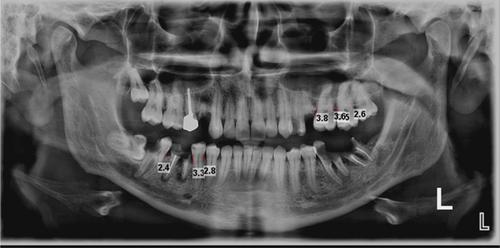Evaluation of Panoramic Radiography Diagnostic Accuracy in the Assessment of Interdental Alveolar Bone Loss Using CBCT
Abstract
Objectives
Alveolar bone loss (ABL) and periodontal lesions are common diseases that have an undeniable effect on teeth maintenance and health. Current diagnostic methods include probing, intraoral radiography, and panoramic radiography; each has its limitations. In this study, we aimed to assess the diagnostic accuracy of panoramic radiography in the diagnosis of interdental ABL.
Material and Methods
In this cross-sectional study, panoramic and cone-beam computed tomography (CBCT) images from 80 patients were collected from the archives of an oral and maxillofacial radiology center. The amount of ABL was obtained by measuring the distance from the Cemento-Enamel Junction (CEJ) to the alveolar bone crest on both panoramic and CBCT images. Patients were divided into healthy (ABL ≤ 2 mm) and diseased (2 mm < ABL) groups in terms of periodontal disease.
Results
There was no statistically significant difference in the average ABL in the premolar, maxillary molar, and mandibular molar areas between the two techniques. However, in other areas, the ABL size was significantly lower in the panoramic view (p < 0.05). Also, the panoramic technique correctly recognized 89.1% of normal and 88.4% of ABL cases. The overall accuracy of panoramic radiography in the diagnosis of ABL was 85%, indicating the good accuracy of this technique. In maxilla, the highest diagnostic accuracy of the panoramic technique was in the molars, and the lowest was in the incisors. In the mandible, the highest and lowest diagnostic accuracy of the panoramic technique was related to molars and premolars, respectively. According to the kappa statistic, there was a significant good to very good agreement between the two types of techniques in all maxillary areas (p < 0.001).
Conclusions
Panoramic radiography is accurate in showing ABL. Measuring ABL in the posterior mandibular areas in panoramic radiographs is quite reliable; however, in general, digital panoramic radiography shows less ABL than the actual amount.


 求助内容:
求助内容: 应助结果提醒方式:
应助结果提醒方式:


